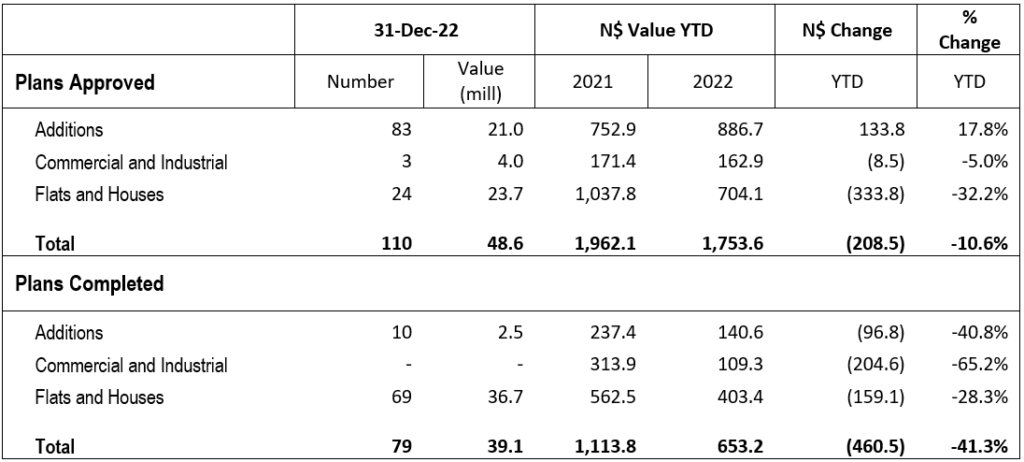
The City of Windhoek approved 110 building plans in December, representing a 42.4% m/m decline from the 191 building plans approved in November. In value terms, the approvals were valued at N$48.6 million, down 58.3% m/m from the N$134.6 million worth of plans approved in November. In total, 2,467 buildings worth N$1.75 billion were approved in 2022, representing an increase of 0.7% y/y in terms of the number of plans approved but a 10.6% y/y contraction in value terms when compared to 2021, and the lowest value since 2011. 79 building plans valued at N$39.1 million were completed in December, bringing the total number of plans completed in 2022 to 1,020 valued at N$653.2 million, the lowest value since 2017.

December saw 83 additions to properties approved valued at N$20.95 million, compared to the 148 units worth N$80.91 million approved in November. In total, 1,675 additions to properties valued at N$886.7 million were approved in 2022, representing a 6.4% y/y increase in the number of plans approved and a 17.8% y/y surge in value terms when compared to 2021. 10 additions worth N$2.47 million were completed in December, notably below the 36 average monthly additions completed in 2022. Overall, 505 additions worth N$140.6 million were completed in 2022, 365 fewer and N$96.8 million less than last year and has been falling since 2018.



As displayed below, the 12-month cumulative value of completed plans also contracted in both nominal and real terms during the month. December also saw the 12-month cumulative number of building plans completed contract for the 20th consecutive month when compared to the number of plans completed over the same period a year ago.

Overall, the construction of new buildings hit a 11-year low in 2022 with the annual value of building plans approved the lowest since 2011. While construction activity in the private sector remains weak, some recovery in activity has been observed in the government sector. According to the Bank of Namibia’s December 2022 Quarterly Bulletin, the government’s expenses reserved for public construction work programmes grew in real terms by 22.9 q/q and 11.5% y/y during Q3 of 2022. Whether this increased investment in construction work by the government will continue over the near term, however, remains to be seen.
While high construction costs continue to weigh on the depressed activity in the sector, the Namibian Statistics Agency’s Q3 PPI data shows that local prices of cement lime and plaster have dropped over the first three quarters of 2022, falling by 11.2% q/q in Q3 alone. However, the 2.6% increase in the minimum wage bill for workers in the construction sector that came into effect in December will all but ease inflationary pressures on the cost of construction over the near term.
Going forward, we see little that will stimulate construction activity in the short-term. Instead, we are of the view that demand will remain depressed under the current economic climate characterised by low economic growth, relatively high inflation, and rising borrowing costs.
